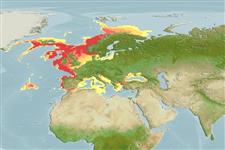Common names from other countries
Classification / Names / Names
Namen | Synonyme | Catalog of Fishes (gen., sp.) | ITIS | CoL | WoRMS
Environment: milieu / climate zone / depth range / distribution range
Ökologie
; tiefenbereich 0 - 1250 m (Ref. 85345). Temperate; 76°N - 1°S, 33°W - 36°E
Atlantic and the Mediterranean Sea: Belgium and Germany. Temperate and subtropical.
Length at first maturity / Size / Gewicht / Alter
Maturity: Lm ? range ? - ? cm Max length : 1.5 cm BL Männchen/unbestimmt; (Ref. 7882)
Oval, flattened body measuring up to 1.5 cm long for species from the North Sea off Belgium (Ref. 7882). Found along the near-coastal and coastal zones usually in medium- to coarse-grained sand with low mud content (maximum of 10%). Turns completely green in color when injured (Ref. 7882). Also occurs on substrates exposed to extensive waves and tidal activity and found on shelly gravel (Ref. 121547).
Life cycle and mating behavior
Geschlechtsreife | Fortpflanzung | Ablaichen | Eier | Fecundity | Larven
Members of the class Echinoidea are gonochoric. Fertilization is external. Brooding is common, eggs are held either on the peristome, around the periproct or deep into the concavities on the petaloids. Life cycle: Embryos develop into planktotrophic larvae (echinoplateus) and live for several months before they sink to the bottom using their tube feet to adhere on the ground where they metamorphose into young urchins.
Harms, J. 1993. (Ref. 2711)
IUCN Rote Liste Status (Ref. 130435)
CITES Status (Ref. 108899)
Not Evaluated
Not Evaluated
Nutzung durch Menschen
| FishSource |
Tools
Internet Quellen
Estimates based on models
Preferred temperature
(Ref.
115969): 5 - 11.3, mean 7.3 (based on 241 cells).
Preiskategorie
Unknown.
